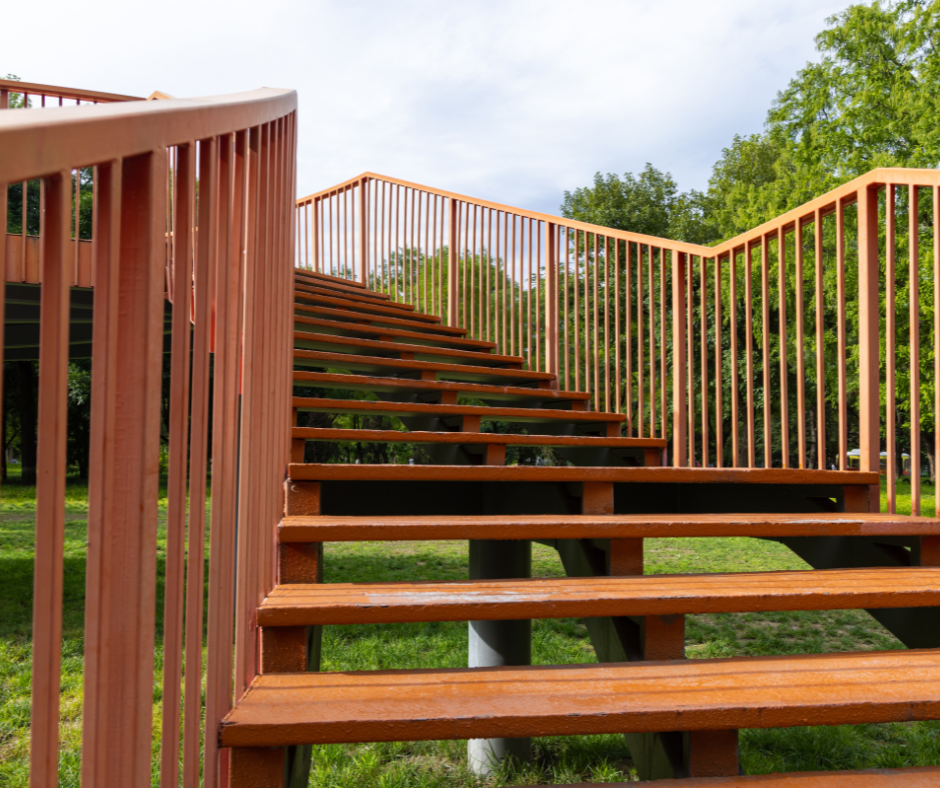Stairs are one of the most used—and overlooked—features in a home, but getting their measurements wrong can lead to safety issues and costly fixes.
So, what is the minimum depth of a stair tread?
According to most building codes, it’s 10 inches, measured from the front to the back of the step, not including any overhang.
In this guide, we’ll explain how that measurement impacts safety, design, and your choice in carpet stair treads.
You’ll also learn how tread depth pairs with riser height, what code requires, and how to create a staircase that’s both functional and beautiful.
Whether you're remodeling or buying treads, these details help you make confident, code-compliant choices.
Why Stair Tread Depth Is More Important Than You Think
Stair tread depth may seem like a small detail, but it plays a big role in everyday safety.
Picture your morning routine.
You’re holding your coffee, the dog’s following behind you, and one of your kids is zooming down the stairs.
Now imagine doing all that on stairs with too little space to walk confidently.
That’s why building codes and home designers pay close attention to tread size.
When treads are too shallow, they increase the risk of tripping or missteps.
For families with kids or pets—or anyone who wants to age comfortably in their home—those inches matter.
A properly sized tread makes every step feel natural.
It supports your full foot and allows you to maintain balance without adjusting your stride.
Understanding the Basics: What Counts as Tread Depth?
Stair tread depth is measured from the front edge (also called the nose or nosing) to the back of the step, where it meets the riser.
When calculating the depth, most building codes exclude the overhang.
That means your tread surface—the part you actually step on—should measure at least 10 inches before adding any additional nosing, according to the International Residential Code (IRC) R311.7.5.2 guidelines.
The recommended stair tread depth for most residential applications typically falls between 10 and 11 inches, which provides ample foot space for secure movement and better comfort throughout daily use.
Anything less than that may not offer the comfort and safety most homeowners are looking for.
Can You Install Shallower Treads?
Technically, some staircases can be built with treads that are slightly shallower than the standard.
This is often the case in historic buildings or when space is extremely limited.
But should you?
Short answer: no.
When treads fall below 10 inches, people start compensating by turning their feet sideways, overstepping, or relying on railings more than they should.
These aren't ideal habits, especially in homes with little ones or older adults.
Even if local building codes allow slightly less, sticking to the recommended stair tread depth of 10 inches or more gives you the best chance of building a staircase that works for every family member, every day.
How Overhang Impacts Tread Feel and Safety
While the tread itself does most of the work, the overhang adds a layer of comfort and protection.
Also called the nosing, this slight projection at the front of each step gives your toes a little extra room to land.
It can also soften the edge of each stair, preventing premature wear and helping reduce slips.
Overhang Best Practices:
-
Should extend between ¾ inch and 1¼ inches from the edge
-
Must be consistent across all steps
-
Shouldn’t be too long—it can become a trip hazard if it extends too far
Though small, the overhang creates a more forgiving step.
It can also improve the look of your stairs by creating visual separation and depth.
Consistency Is Critical
The depth of your stair treads doesn’t just need to meet a minimum—it needs to be consistent from top to bottom.
Having one or two steps that are slightly different in depth might seem harmless, but it can throw off your muscle memory and lead to stumbles or trips.
Most stair tread depth requirements only allow a variation of up to ⅜ inch between any two treads in a staircase.
That might not sound like much, but it’s enough to make a difference in how natural your stairs feel underfoot.
Uniform depth also helps with visual harmony—something especially important in open staircases or stairways visible from other parts of the home.
Stair Depth and Traffic: One Size Doesn’t Fit All
Different spaces call for different stair solutions.
In homes, the minimum tread depth of 10 inches usually works well.
But in busier spaces—like offices, schools, or apartment buildings—you’ll often see 11-inch treads or more.
Why?
The more people use the stairs, the more room they need to feel secure.
Larger treads help manage foot traffic, reduce collisions, and improve long-term comfort for users.
So while 10 inches might meet code in most homes, keep in mind that more room isn’t a bad thing—especially if you’re designing stairs that’ll see a lot of use.
How Tread Depth Affects DIY Installations
If you’re thinking about installing stair treads yourself, understanding tread depth becomes even more important.
At Oak Valley Designs, our stair treads are custom-cut to fit individual steps, not installed as one long runner.
That means when you place an order, you’ll need to know the exact depth of each stair, excluding the overhang.
And here’s where it gets even easier: we provide a wide range of sizes and custom dimensions, so no matter your stair layout, you can get a perfect fit.
Plus, our DIY-friendly installation doesn’t involve staples or nails—just strong, eco-safe adhesive that won’t damage your floors.
If your stairs are on the smaller side, it’s even more important to get the measurements right to avoid leaving too much wood exposed or covering areas where the tread shouldn’t reach.
What the Codes Say: Residential vs. Commercial Requirements
Whether you're building from scratch or upgrading your existing staircase, it's worth understanding the difference between residential and commercial stair standards.
Residential Stair Codes (Most Common):
-
Minimum tread depth: 10 inches
-
Maximum riser height: 7¾ inches
-
Minimum riser height: 4 inches
-
Allowed variance between steps: ≤ ⅜ inch
Commercial Stair Codes (Higher Traffic Areas):
-
Minimum tread depth: 11 inches
-
Maximum riser height: 7 inches
-
Handrails required on both sides
-
Nosing often required unless tread depth is ≥ 11 inches
These guidelines are based on the International Code Council’s 2021 International Residential Code (IRC) and International Building Code (IBC).
Always check with your local building authority to confirm specific requirements, as they may vary by state or city.
Even if your project qualifies for exceptions, sticking to these widely accepted stair tread depth requirements helps ensure your staircase meets both safety and comfort standards—for now and in the future.
Riser Height and Tread Depth: A Balanced Duo
One of the easiest ways to tell if your stair design is on track is by using a simple formula:
Riser Height + Tread Depth = 17 to 18 inches
This rule keeps your stairs comfortable to climb. For example:
-
If your riser is 7 inches, your tread should be 10–11 inches.
-
If your riser is higher (say 7.5 inches), a slightly deeper tread of 10.5 inches helps maintain that balance.
Get too far outside that range, and stairs start to feel either too steep or too shallow—which can be both uncomfortable and unsafe.
Are Deeper Treads Always Better?
While the minimum depth requirement is clear, some homeowners wonder if they should go deeper than 10 or 11 inches.
Here are some benefits to deeper treads:
-
More comfort: Feels like walking on level ground
-
Easier for pets or seniors: Safer and less stressful to use
-
Better aesthetics: Provides a luxury look, especially in open staircases
The trade-off? Deeper treads usually require a larger staircase footprint.
If you’re working with limited space, you’ll need to strike a balance between depth and riser height to avoid overly steep stairs.
Stepping It Up
Understanding what is the minimum depth of a stair tread isn’t just a matter of checking building codes—it’s about building a staircase that supports your lifestyle, your design vision, and your family's safety.
A tread depth of at least 10 inches meets most building codes and provides the comfort and confidence your stairs need.
When combined with a subtle overhang, consistent sizing, and thoughtful riser height, it all adds up to one thing: better stairs.
At Oak Valley Designs, we’ve built our entire brand around making stairs safer, more stylish, and more functional for modern families.
With customizable options, made-in-the-USA quality, and easy DIY installation, we’re here to help you take the next step—literally.
Ready to Upgrade Your Stairs?
Don’t settle for outdated runners or risky stair surfaces.
Choose a better way to protect your steps—with style, ease, and peace of mind.
-
Website: https://oakvalleydesigns.com/
-
Phone: 706.331.0315
-
Email: info@oakvalleydesigns.com
-
Address: 30 River Ct SW Bldg E Cartersville, Ga 30120




